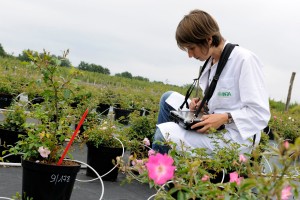- Index
- >Innovation
- >The innovation box
- >4. Innovate thanks to sensory analysis
- >Review of the main concepts
Sensory analysis, a tool to assess product quality
 Evaluation of a product quality is SUBJECTIVE.
Evaluation of a product quality is SUBJECTIVE.
Numerous biases may modify consumers’ perceptions (adaptation, tiredness, interactions between testers…)
Sensory analysis is a science based on a set of methods measuring sensory perceptions.
It enables to assess:
|
differences |
preferences |
attitudes, motivations, behavior |
|
|
|
« Qualitative » trials performed by consumers without any training |
Understanding consumers’ liking to support innovation
Sensory analysis links:
- the results from expert panels ( = sensory descriptions)
- the results from consumer test ( = sensory preferences)
To map sensory preferences of consumers on the basis of objective criteria and help professionals to:
- breed plants that meet consumers’ expectations
- segment their products
- improve their marketing communication

Sensotype the products to accelerate plante breeding and segmentation
|
Research centers develop alternatives to traditional sensory analysis in order to face the high-throughput phenotyping challenge: be able to characterize a high number of samples in a short amount of time. |
|
For this purpose, sensotyping tools were developed to get simplified descriptive sensory analyses that are easy-to-use for the professionnals to quickly screen new products.
Example: faster sensory evaluation of taste, texture or visual aspect of a fruit or a plant in relation with quantification of a physical, chemical or biological markers. |
Sensory analysis is a transversal science that enables numerous research teams of SFR Quasav to work towards creation of plant products that meet producers and consumers expectations: new varieties of apples, pears, roses, new cultural practices to improve aesthetic quality of ornamental plants, new process to improve the organoleptic qualities of wine or cider… The researchers of GRAPPE laboratory (ESA, unit under contract with INRA) and of some teams of IRHS have been producing knowledge, methods and tools dedicated to the professionals of the plant sector in order to better understand the consumers’ expectations and integrate them in the innovation process.
Contacts
Looking for partnership?
Four contacts to help you build your projects and support them:
- Céline Brasse,
 in charge of Cellule Etudes of GRAPPE research unit.
in charge of Cellule Etudes of GRAPPE research unit.
- Olivier Dubois,
 mission head Development Companies and Territories.
mission head Development Companies and Territories.
- Ronan Symoneaux,
 research engineer Sensory analysis.
research engineer Sensory analysis.
- Tanegmart Redjala,
 close interface with the laboratories of the Research Federative Structure Quasav.
close interface with the laboratories of the Research Federative Structure Quasav.






